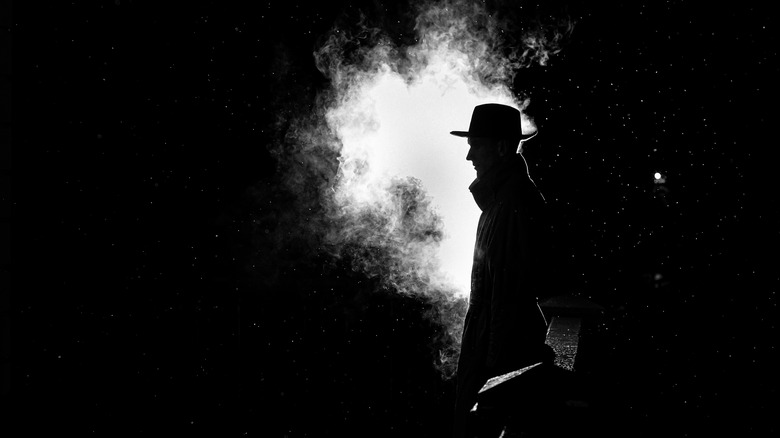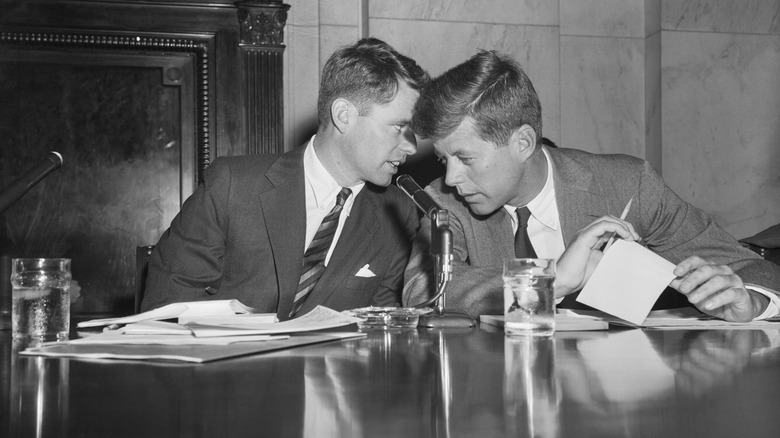A Labor Union Leader Was Shot Dead In 1952. Why His Murder Remains Unsolved
John Acropolis was a tough no-nonsense union leader. He'd been in plenty of scrapes over the years. But in the early morning of August 26, 1952, Acropolis, known by many as "Little Caesar," who was the head of Teamsters Local 456, met his end, according to The Journal News. Someone put two bullets in his head as he returned to his Yonkers, New York apartment. He was carrying a suit he'd picked up earlier that day from a tailor and had his car keys in his hand, according to testimony from a 1957 U.S. Senate hearing. Edward Doyle, the local's vice president, discovered Acropolis inside his home near the front door the next day.
A few weeks before Acropolis' murder, the heads of another union based in the Bronx with Mafia ties threatened Acropolis for refusing to play ball with the mobsters who were attempting to take over the local garbage hauling business. The Yonkers Police investigation went nowhere amid allegations of a bungled case and although it went before a grand jury no one was ever arrested, much less convicted of the murder.
Mafia muscles in on the garbage business
John Acropolis had grown up in an orphanage after both his parents had died by the time he was 3, according to The Herald Statesman. He was smart and athletic and went on to attend Colgate University before getting into union organizing. He was in the U.S. Navy during World War II and by the time of his murder at age 43 he was the president of the Westchester Federation of Labor and of Local 456. The catalyst that led to his murder involved the Yonkers' garbage business. In 1950, the city government decided it would no longer be responsible for picking up the trash from local businesses, which meant private contractors would be handling the lucrative work, according to the testimony from the 1957 Senate hearing.
The mob began muscling in on the trade through an entity called Westchester Carting. They began threatening other garbage companies "to get out of the business" and burned "people's trucks and equipment," Edward Doyle testified in 1947 under questioning by Robert F. Kennedy, who was chief counsel for the Senate committee in charge of investigating labor corruption. Doyle also testified that just three weeks before Acropolis' murder Joe Parisi and Bernie Adelstein of Teamsters Local 27 threatened Acropolis. Both men were associates of the New York Mafia with long criminal records, per "Contract on America: the Mafia Murder of President John F. Kennedy."
Police investigation went nowhere
In the wake of John Acropolis' murder, the Yonkers Police Department began an intensive investigation with the help of Westchester police and the NYPD, interviewing several hundred people, but with little visible result. The police didn't even find the murder weapon — which had been tossed into the bushes near Acropolis' apartment — for six years, per The Journal News. When they did, the gun was so damaged from being outside that they couldn't conclusively match it to the slugs they'd recovered. The closest anyone ever came to tying the murder to the Mafia was Robert Kennedy as part of the U.S. Senate hearings, determining simply "local 456's president, John Acropolis, was murdered in the wake of threats from Adelstein and Parisi."
Nearly 60 years later, the ACLU sued the Yonkers Police over the agency's refusal to turn over case files related to Acropolis' murder to John Bly, a writer who knew Acropolis personally and planned to write a book on the killing, according to The New York Times. The Yonkers police fought the request that ended up requiring the state Supreme Court to step in and order the agency to turn over the files, per the NYCLU. To this day, the Yonkers Police have not solved the murder, which officially remains an open investigation. "Anybody who might have known anything is probably long dead by now," Bernard Doyle, the son of the man who found Acropolis' body, told The Journal News in 2002.


